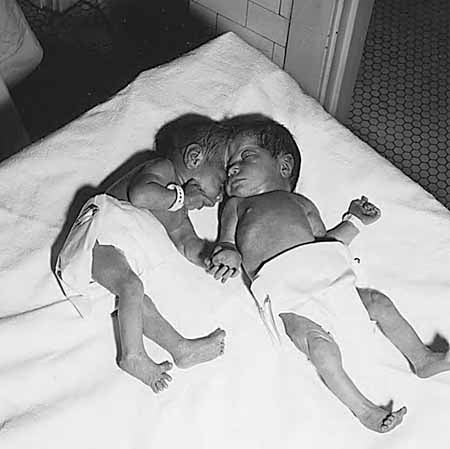Teresa Bunton, one of famed Siamese twins, dies at age 60
Published 8:29 am Monday, February 27, 2017
Death came on Valentine’s Day to Teresa K. Bunton, one of the Siamese twins born to Virginia Maude McCloud Bunton and her late husband, Raymond, in 1956.
Teresa and her sister, Virginia “Ginny”, were the first set of conjoined twins born in the Tri-Cities area. The twins were born on August 9 at the old St. Elizabeth Hospital with Dr. W.G. Frost as the attending physician.
Teresa, 60, died at the Johnston Memorial Hospital in Abingdon, Va., following a lengthy illness.
From the time they were born until later in life, the twins have been the subject of attention by doctors, and are the only case on record of Siamese twins joined at the head and brain, who were successfully separated by surgery, enabling them to lead normal active lives.
Both the twins spent much of their life in Butler. Ginny (Wagner) is the mother of a son and has a grandson. Teresa, who was married to Rick Ward, lived in Indiana for 15 years before divorcing and moving back to Butler in 1991. The sisters had a brother, Gary Bunton, who is deceased, and an older sister, Clarice Bunton.
Both, Ginny and Teresa knew they were miracle babies. For the first few months of their lives, they were solidly joined to each other, skull to skull, brain to brain, right forehead embedded in right forehead. When they were born, no one thought they would survive the surgery necessary to separate them.
According to statistics, such a juncture happens once in every two to four million births. There have been some cases of twins joined at the body (which is less rare), but had been separated by surgery, but the doctors knew of no case which the juncture was at the forehead.
Although they were full term infants, their combined weight at birth was only seven pounds, about that of an average baby at birth.
It was on August 9, 1956, that Mrs. Virginia Maude Bunton, her father, and a neighbor climbed into a Plymouth at 3 a.m. and twisted along the winding mountain road from Butler to the old St. Elizabeth Hospital, 30 miles away.
She was 23 years old and three months a widow. It was her third delivery and it nearly killed her. A day later her tired father, John McCloud, a Baptist preacher, appeared with the news that his daughter had given birth to Siamese twins, joined above the right foreheads. Doctors expected neither tiny Teresa Kay nor Virginia Kate to live.

The Bunton twins, Ginny and Teresa, at 15 months old with their mother, Mrs. Virginia McCloud Bunton.
They did, and Teresa in a 2009 interview with this reporter shared that it was when she was 10 or 11 years old that she first realized what it was all about. “It really felt good to be one of them, a Siamese twin, and that we lived, and lived to be separated, and we lived afterwards, too,” she said.
Whatever excitement the births caused around Butler, the news was not quite so big beyond East Tennessee. A four-paragraph Associated Press dispatch was the only notice printed in Nashville’s morning paper.
But word reached the late U.S. Rep. B. Carroll Reece from the First Congressional District, who was also from Butler. On October 1, Reece flew Mrs. Bunton and the infants to the National Institute of Neurological Disease and Blindness, a clinical center at the National Institutes of Health at Bethesda, Md.
A Dr. Baldwin took charge of the case and the government paid the expense. The girls’ father, Raymond, was a 29-year-old disabled veteran when he died of a heart attack and his children were entitled to medical benefits.
The tissue linking Ginny and Teresa was less than 3 inches by 4 inches. But there was an outside chance the brains were bridged, and the operation was only the third of its kind.
On Dec. 11, 1956, in a seven-hour surgery, the girls were parted. They were four months and two days old.
For the first time, the babies slept in separate cribs. Soon, each rested with a large doll so she wouldn’t miss the other twin.
Though sections of embryonic calfskin were successfully grafted across the open skulls, the girls lost copious amounts of fluids from their brains.
The girls were 14 months old before they returned home to Bunton Hollow.
With the supplementary surgeries and examinations, the NIH hospital became their second home throughout their childhood.
Teresa said all she could remember was when they went back to the hospital, their hair was always cut and “we were shaved baldheaded.”
“I’d always end up crying because I didn’t want them to cut my hair,” she shared.
Ginny and Teresa attended public school their first year, but from then on through high school, they were taught at home by Mrs. Worley Ward. They had the same homebound teacher all through school.
The girls had photos made for the high school annual and attended Johnson County High School in Mountain City for the first time on graduation day.
A year earlier, Rick Ward had come down from Indiana to visit his grandparent. In December, after Teresa finished school, he married Teresa and they moved to Grainger, Ind., a suburb of South Bend, where they lived with his parents.
Ginny stayed behind in Butler, but did marry later.
Teresa, described as a kind-hearted, caring person, always had a smile said Mrs. Mac Holloway, a family friend. “The girls grew up very poor, but they had their pride. They always wore their hair long, and kept it combed over the place on their forehead, where they were joined. They always thought of themselves as normal,” she said.
“Yes, I would say we were miracles,” Ginny said. She said the care and attention given to them by their mother played a large part in their having an active and normal life. “She not only took good care of us, but taught us how to care for ourselves and be independent,” Ginny said.
Ginny said Teresa was a wonderful sister. She said her sister enjoyed cooking and loved her little dogs.
Teresa was a member of Sugar Grove Baptist Church. She was laid to rest last Sunday afternoon in the Sugar Grove Baptist Church Cemetery.





